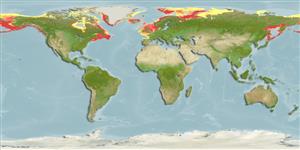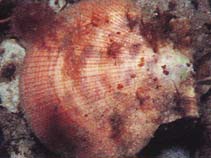Chlamys islandica (Müller, 1776)
Iceland scallop| Native range | All suitable habitat | Point map | Year 2050 |

|
| This map was computer-generated and has not yet been reviewed. |
| Chlamys islandica AquaMaps Data sources: GBIF OBIS |
Classification / Names Κοινά ονόματα | Συνώνυμα | CoL | ITIS | WoRMS
Bivalvia | Pectinida | Pectinidae
Environment: milieu / climate zone / εύρος βάθους / distribution range Οικολογία
; εύρος βάθους 4 - 250 m (Αναφ. 3710), usually 40 - 100 m (Αναφ. 106788). Polar; ? - 15°C (Αναφ. 3706), preferred 10°C (Αναφ. 107945); 82°N - 32°N, 180°W - 180°E
Distribution Χώρες | Περιοχές FAO | Οικοσυστήματα | Παρουσίες | Εισαγωγές
Atlantic Ocean, Pacific and the Arctic: UK and Canadian Arctic Archipelago, Alaska to USA and Japan. Subtropical to polar.
Length at first maturity / Μέγεθος / Weight / Age
Γεννητική Ωρίμανση: Lm ? range ? - ? cm Max length : 11.0 cm SHL αρσενικό/απροσδιόριστο; (Αναφ. 78075); μεγ. αναφερόμενη ηλικία: 23 έτη (Αναφ. 8702)
Life cycle and mating behavior Γεννητική Ωρίμανση | Αναπαραγωγή | Γεννοβολία | Eggs | Γονιμότητα | Larvae
Main reference
Αναφορές | Συντονιστής | Συνεργάτες
Wiborg, K.F. 1963 Some observations on the Iceland scallop Chlamys islandica (Müller) in Norwegian waters. Fiskeridirektoratets Skrifter Serie Havundersogelser 13:38-53. (Αναφ. 3710)
IUCN Red List Status
(Αναφ. 130435: Version 2025-1)
CITES status (Αναφ. 108899)
CMS (Αναφ. 116361)
Threat to humans
Human uses
αλιεία: Εμπορικό(ά)
FAO - αλιεία: landings | FishSource | Η θάλασσα γύρω μας
Εργαλεία
Περισσότερες πληροφορίες
Διαδικτυακές πηγές
BHL | BOLD Systems | CISTI | DiscoverLife | FAO(αλιεία: ; publication : search) | Fishipedia | GenBank (genome, nucleotide) | GloBI | Gomexsi | Google Books | Google Scholar | Google | PubMed | Δέντρο Ζωής | Wikipedia (Go, αναζήτηση) | Zoological Record



